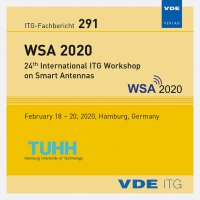Investigation of Optimal MCS and Subcarrier Spacing in MBSFN Systems
Konferenz: WSA 2020 - 24th International ITG Workshop on Smart Antennas
18.02.2020 - 20.02.2020 in Hamburg, Germany
Tagungsband: WSA 2020
Seiten: 6Sprache: EnglischTyp: PDF
Persönliche VDE-Mitglieder erhalten auf diesen Artikel 10% Rabatt
Autoren:
Kirev, Kiril; Schwarz, Stefan (Christian Doppler Laboratory for Dependable Wireless Connectivity for the Society in Motion, TU Wien, Institute of Telecommunications, Gusshausstrasse 25/389, 1040 Vienna, Austria)
Inhalt:
LTE Rel’ 14 is the latest release in which enhancements to Multimedia Broadcast Multicast Services (MBMS) were introduced. Among the more prominent ones are the newly defined numerologies that allow for even smaller SubCarrier Spacing (SCS), the allowance for all resources in a subframe to be allocated to broadcasting services, dynamically allocate cells to dedicated broadcast transmission and new Modulation and Coding Scheme (MCS) values with support for up to 256 Quadrature Amplitude Modulation (QAM) modulation. These new numerologies define even longer Cyclic Prefixes to help combat multipath propagation effects with echoes with long delays, thus allowing for larger inter-cell distances. A natural consequence is the decrease in resource elements for user data and thus a decrease in maximum throughput. Another consideration is the increase in sensitivity towards Doppler spread with decreasing SCS, giving rise to a trade-off between user mobility and mitigating multipath echoes. In this paper we investigate combinations of MCS and SCS under a Single Frequency Network (SFN) transmission mode across the cell and towards the border in order to find the most resilient one under the assumption of user mobility and compare the performance to a multiple cell scenario with neighboring interferers.


